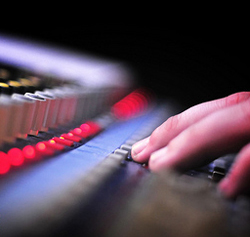
5) Optimize Mic Technique. Review microphone selection and placements on stage. Choosing appropriate mics and optimizing placement can influence the PA mix notably by reducing leakage, increasing gain-before-feedback, and capturing better sounding sources.
6) Cue Sheets. Get a copy of whatever cue/tech sheet or order of service outline is available, or draw one up if not. Clearly mark mic and roll-in cues, and any other important audio notes, in advance of sound check. Mixing notes can be added during sound check.
If mixing on a suitable digital platform, it may be possible to pre-program some or all of the cues and mix changes. But manual control should always be available, and the cue sheet should always be visible, whether in paper or electronic form. For very busy events, such as dramatic pageants, enlist an assistant to manage and announce the cues.
7) Sound Check Is Not Set Up. Clearly distinguish between setup and sound check. Sound check is the time for audio personnel to dial in the mixes, with the elements (gear and musicians, etc.) working exactly as they will be during the worship service. Complete all audio setup work in advance of sound check so that sound check really is just that – sound check!
8) I/O Checks. Some worship audio techs add an input/output check procedure prior to sound check. This is highly recommended. I/O check takes a sound source (such as a CD), one person on stage, and one person at each mix position (two people in many church applications).
Every input and output is briefly tested over the PA system (inputs) and over wedges or earphones (outputs). It’s a 5- or 10-minute effort at most, and this procedure verifies the entire signal paths from sources to worshippers (front of house) and sources to artists (monitors). And the occasional I/O that doesn’t work is identified and hopefully resolved before the worship team hits the stage – preserving sound check.
9) Review Mixes. If you record your mixes, review them. If you’re making a classic “board tape” right off the console’s PA mix, listen to it with the knowledge that it is mixed for the house sound and does not include the live acoustic portion of the listening experience (which affects mix balance).
If you multi-track services, you’ve got a great practice and training tool – play the tracks back through the front of house console. And if you’re fortunate enough to own a digital mixing platform that offers “virtual sound check” technology, you’ve got the ultimate tool for practicing, training, and fine tuning the sound reinforcement mix.
10) Ear Training. Good mixing requires good listening skills, which require training and practice. Listen to great mixes that are relevant to your worship style, and “take them apart” mentally.
Discover the details that make good blends and mixes. Train your ears to identify frequency ranges. This skill is critical for sound reinforcement mixing, and there are a number of useful training tools on the market—opractice with a tone generator and RTA (real time analyzer). Some worship audio techs add an input/output check procedure prior to sound check. This is highly recommended. I/O check takes a sound source (such as a CD), one person on stage, and one person at each mix position (two people in many church applications).
Every input and output is briefly tested over the PA system (inputs) and over wedges or earphones (outputs). It’s a 5- or 10-minute effort at most, and this procedure verifies the entire signal paths from sources to worshippers (front of house) and sources to artists (monitors). And the occasional I/O that doesn’t work is identified and hopefully resolved before the worship team hits the stage – preserving sound check.
Kent Margraves began with a B.S. in Music Business and soon migrated to the other end of the spectrum with a serious passion for audio engineering. Over the past 25 years he has spent time as a staff audio director at two mega churches, worked as worship applications specialist at Sennheiser and Digidesign, and toured the world as a concert front of house engineer. Margraves currently serves the worship technology market at WAVE (wave.us) and continues to mix heavily in several notable worship environments including his home church, Elevation Church, in Charlotte, NC. His mission is simply to lead ministries in achieving their best and most un-distracted worship experience through technical excellence. His specialties are mixing techniques, teaching, and RF system optimization.
